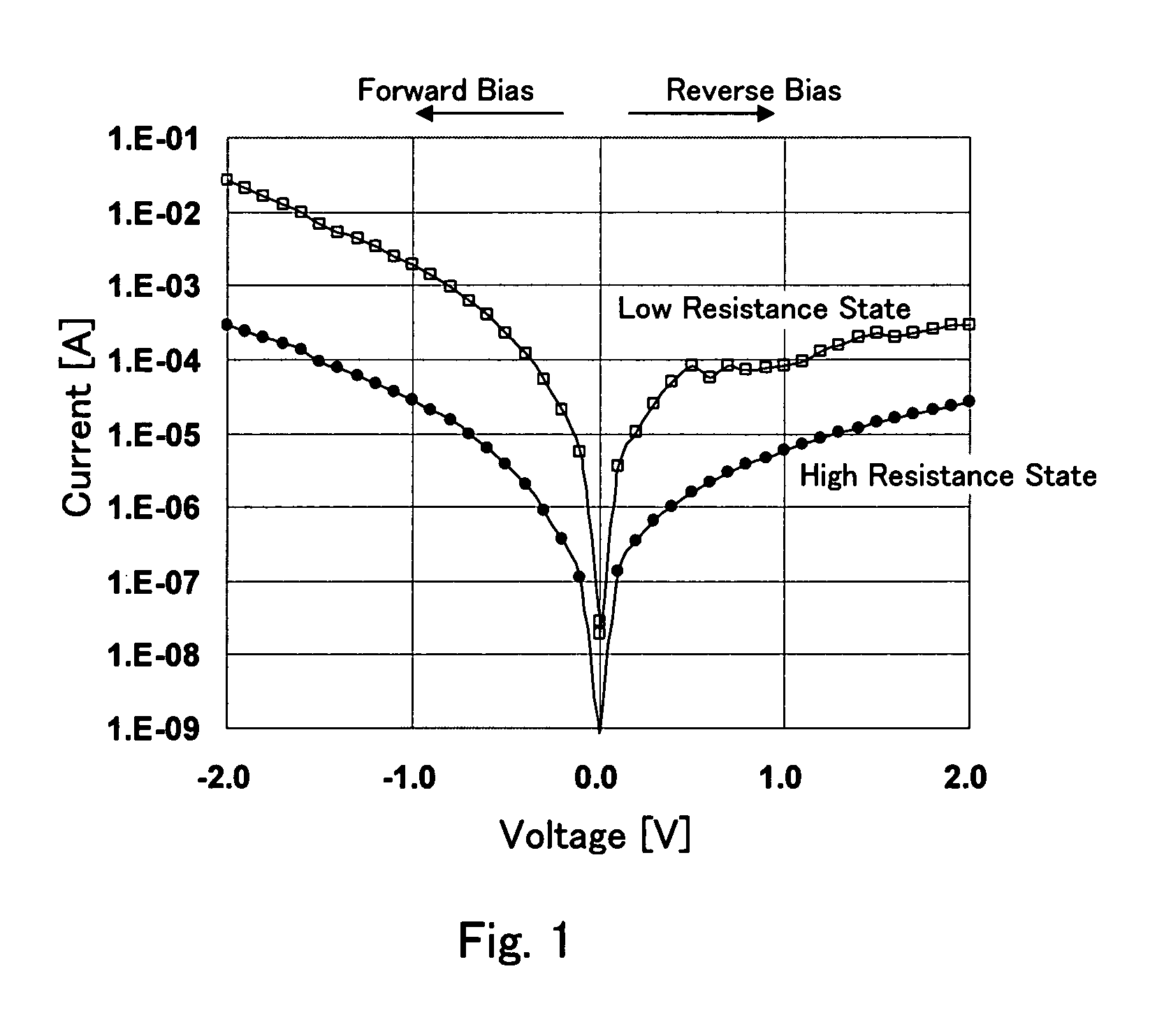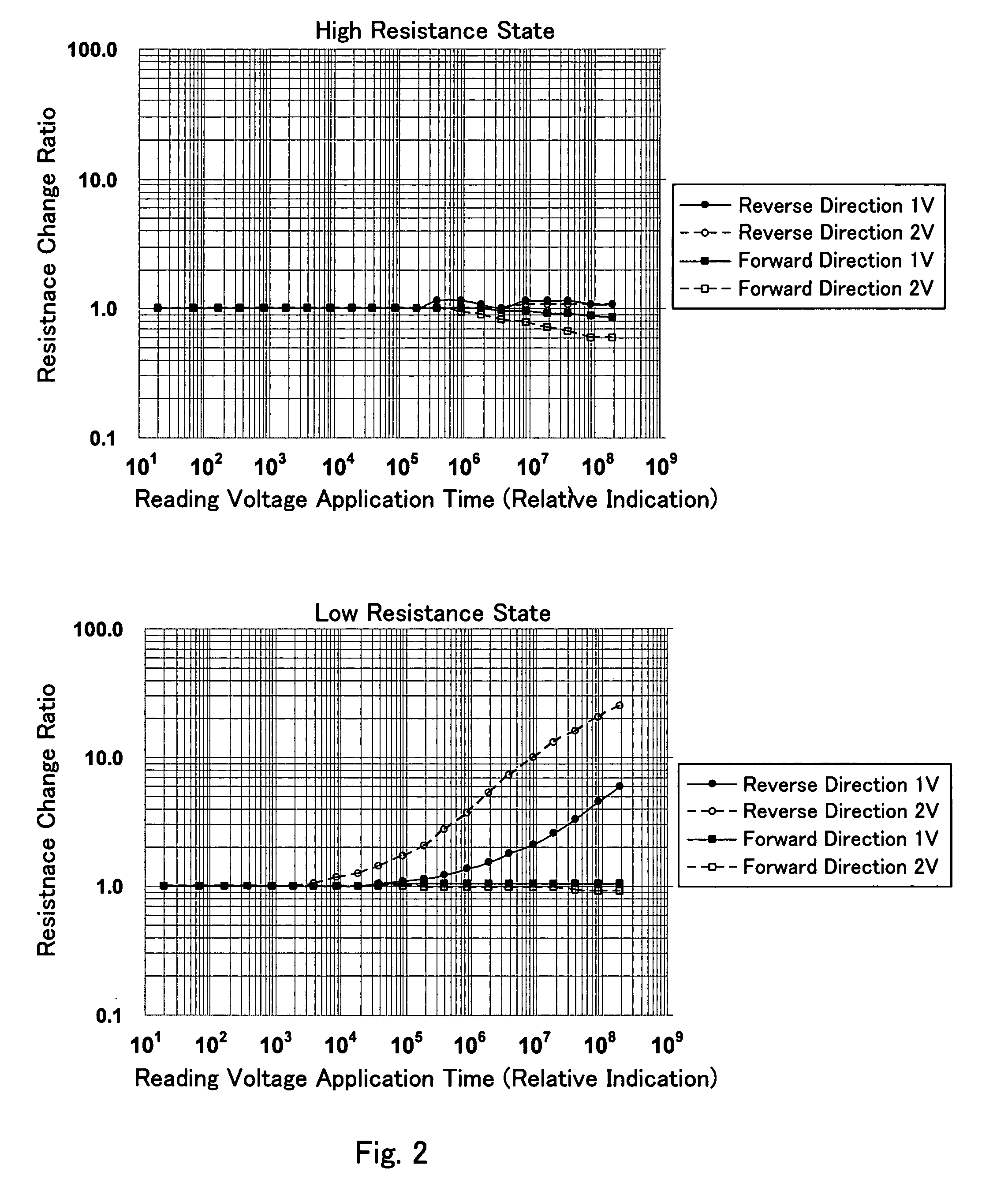Nonvolatile semiconductor memory device
a semiconductor memory and non-volatile technology, applied in static storage, digital storage, instruments, etc., can solve the problems of inability to read in the worse case, inability to record information, and inability to completely lose stored data, so as to achieve the effect of suppressing the resistance change of the variable resistance element due to the reading disturban
- Summary
- Abstract
- Description
- Claims
- Application Information
AI Technical Summary
Benefits of technology
Problems solved by technology
Method used
Image
Examples
first embodiment
[0059]FIG. 5 shows the schematic constitution of a device of the present invention according to a first embodiment. As shown in FIG. 5, the device of the present invention comprises a bit line decoder 16, a word line decoder 17, a voltage switch circuit 22, a readout circuit 23, a voltage generation circuit 24, and a control circuit 20 in the vicinity of a memory cell array 25 in which 1R-type memory cells are arranged in a matrix state.
[0060]As shown in FIG. 6, the memory cell array 25 is provided such that each of m×n memory cells 1 is disposed at each intersection of m bit lines extending in a column direction (corresponding to a column selection line) BL1 to BLm and n word lines extending in a row direction (corresponding to a row selection line) WL1 to WLn. The variable resistance element 3 constituting each memory cell 1 has the rectifying characteristics and it is connected to the word line and the bit line such that the current flowing from the bit line to the word line beco...
second embodiment
[0070]Although the description has been made of the case where the memory cell is the 1R-type memory cell in the first embodiment, a description will be made of a case where the memory cell is an 1T / 1R-type memory cell hereinafter.
[0071]FIG. 10 shows the schematic constitution of a device of the present invention according to a second embodiment. As shown in FIG. 10, the device of the present invention comprises a word line decoder 7, a bit line decoder 6, a source line decoder 5, a voltage switch circuit 12, a readout circuit 13, a voltage generation circuit 14, and a control circuit 10 in the vicinity of a memory cell array 15 in which 1T / 1R-type memory cells are arranged in a matrix state. A specific memory cell in the memory cell array 15 corresponding to an address inputted from an address line 8 to the control circuit 10 is selected by the bit line decoder 6, the source line decoder 5 and the word line decoder 7 and the data is programmed, erased or read and the data is stored...
third embodiment
[0083]FIG. 14 shows the schematic constitution of a device of the present invention according to the third embodiment. As shown in FIG. 14, although the device of the present invention has the same constitution as that of the 1R-type memory cell basically, since the memory cell comprises a series circuit consisting of a variable resistance element and a cell-access diode, it is necessary to turn on the cell-access diode of the selected memory cell in the reading operation, so that its voltage applying condition is different from that of the 1R-type memory cell. As shown in FIG. 14, the device of the present invention comprises a bit line decoder 26, a word line decoder 27, a voltage switch circuit 32a, a readout circuit 33a, a voltage generation circuit 34a, and a control circuit 30a in the vicinity of a memory cell array 35a in which 1D / 1R-type memory cells are arranged in a matrix state.
[0084]As shown in FIG. 15, the memory cell array 35a is constituted such that each of m×n memor...
PUM
 Login to View More
Login to View More Abstract
Description
Claims
Application Information
 Login to View More
Login to View More - R&D
- Intellectual Property
- Life Sciences
- Materials
- Tech Scout
- Unparalleled Data Quality
- Higher Quality Content
- 60% Fewer Hallucinations
Browse by: Latest US Patents, China's latest patents, Technical Efficacy Thesaurus, Application Domain, Technology Topic, Popular Technical Reports.
© 2025 PatSnap. All rights reserved.Legal|Privacy policy|Modern Slavery Act Transparency Statement|Sitemap|About US| Contact US: help@patsnap.com



